We explore the Indian Ocean, and discuss its location and extent. In addition, we describe its characteristics, ocean currents, and more.
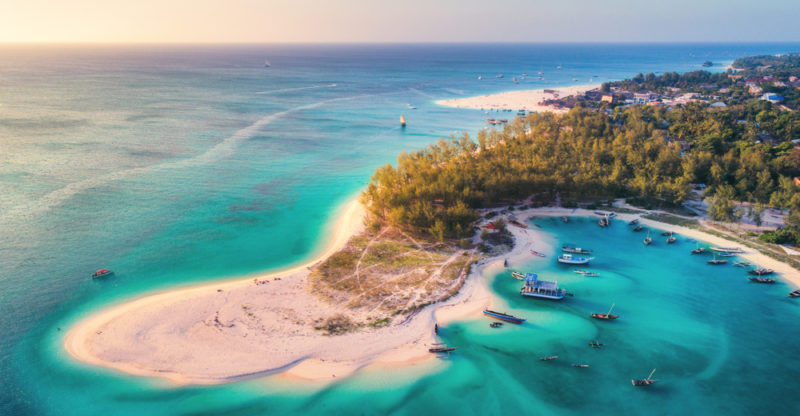
What is the Indian Ocean?
The Indian Ocean is one of the world's five oceans, bounded by four continents: Africa, Asia, Antarctica, and Oceania. It covers an area of about 27 million square miles (70 million km2), making it the third-largest ocean on the planet, after the Pacific and the Atlantic.
Its maximum width is about 6,215 miles (10,000 km), while its maximum length is estimated at 4,350 miles (7,000 km). The waters of the Indian Ocean are connected to other bodies of water, including the Red Sea — through the Bab el-Mandeb Strait, and the Persian Gulf —through the Strait of Hormuz.
Its seafloor shows numerous underwater volcanic chains as well as the Sunda Trench, the deepest point in the Indian Ocean and one of the deepest ocean trenches in the world.
The Indian Ocean plays a key role in the global economy, being a major route for global trade, and hosting some of the world’s busiest maritime routes. In addition, its waters are rich in natural resources such as oil and gas. Likewise, fishing and tourism are major economic activities for many of its coastal countries.
- See also: Arctic Ocean
Indian Ocean facts
The main characteristics of the Indian Ocean are:
- It covers about 20% of the Earth's surface.
- It is the third-largest ocean on the planet.
- Its extent is about 27 million square miles (70 million km2).
- It began to form 200 million years ago.
- It harbors significant fishing and oil resources.
- Monsoon winds are among its main climate features.
- Chemical and plastic pollution are among its major environmental threats.
Major rivers flowing into the Indian Ocean are the Ganges, Brahmaputra, Indus, and Zambezi.
How was the Indian Ocean formed?
During the Mesozoic Era, about 200 million years ago, the continents, which until then formed a single supercontinent called Pangea, began to break apart. The fragmentation of Gondwana, a subdivision of Pangea, caused tectonic plates to drift, eventually becoming Africa, South America, Antarctica, Australia, and India.
About 100 million years ago, the Indian Plate began to drift northward, driven by the spreading of the Indian Ocean floor. This caused the Indian Plate and the Eurasian Plate to collide, forming the Himalayan mountain range and marking the last boundary of the Indian Ocean.
Indian Ocean currents
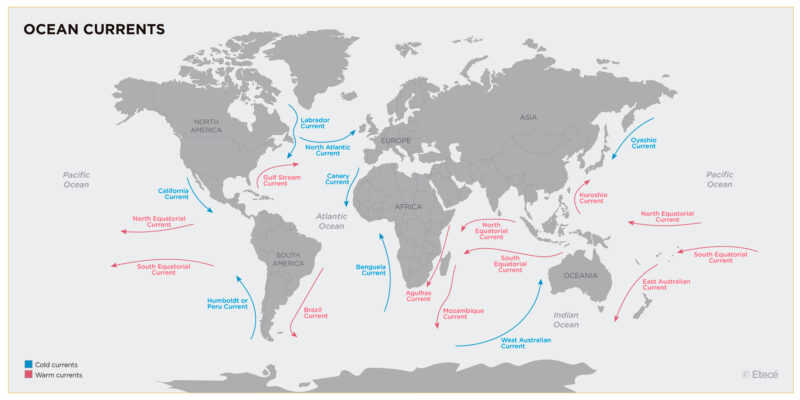
Differences in water temperature cause ocean currents to form. These are water flows that are in continuous movement within the oceans. The main ocean currents that circulate through the Indian Ocean are:
Cold current:
- West Australian Current. It flows northward from Antarctica along the western coast of Australia.
Warm currents:
- Agulhas Current. It flows north-south along the eastern coast of Africa, between Africa and the island of Madagascar.
- Mozambique Current. It flows southward along the eastern coast of Madagascar.
- North Equatorial Current. It flows from east to west between latitudes 10°N and 15°N.
- South Equatorial Current. It flows from east to west between latitudes 10°S and 15°S.
Flora and fauna of the Indian Ocean
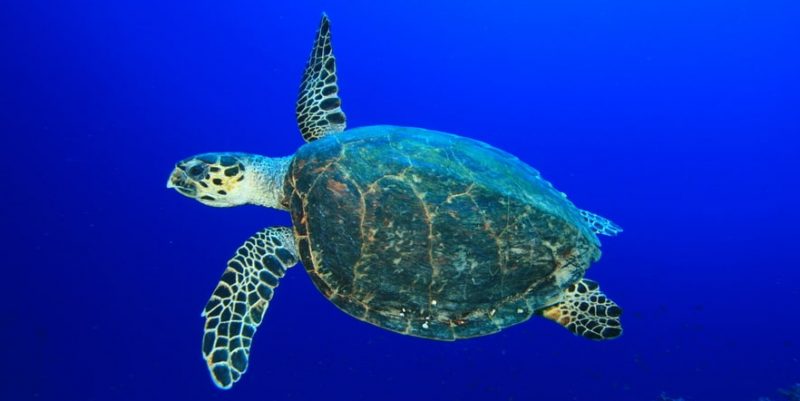
The flora of the Indian Ocean is characterized by the presence of phytoplankton and seaweeds. These organisms constitute the base of the marine food chain and are vital for the production of oxygen and carbon dioxide capture through photosynthesis.
The Indian Ocean is home to a wide variety of fauna, including the leatherback turtle, the world’s largest, and the only sea turtle without a hard shell. It also hosts large predators such as tiger sharks and swordfish, as well as cetaceans like dolphins and whales. The Indian Ocean harbors large coral reefs, especially near the Seychelles and Maldives Islands.
Indian Ocean climate
The Indian Ocean climate is marked by the presence of monsoon winds, which are seasonal winds, that is, winds that change direction with the seasons. This climate phenomenon influences temperature and rainfall over vast inland regions, affecting the daily lives of billions of people.
The monsoon winds are caused by the difference in temperature between the land surface and the Indian Ocean. Two types of monsoon winds exist:
- Summer monsoon. During the summer, the land heats up at a higher speed than the sea, creating a low-pressure system on the continent that attracts moist winds from the ocean. This results in hot, rainy summers in South Asia.
- Winter monsoon. During the winter, the land cools down more rapidly than the sea, creating a low-pressure system over the ocean that attracts dry winds, and blocks the flow of moist winds into the continent. This results in cold winters with virtually no rainfall in South Asia.
Natural resources of the Indian Ocean
The Indian Ocean is home to a diversity of fish, shellfish, and crustacean species that are crucial for fishery, aquaculture, and the economies of a large number of coastal countries. Among its most highly-coveted species are tuna, shrimp, squid, and cod.
Likewise, the Indian Ocean is rich in energy resources, particularly oil and gas. Exploration and drilling for these resources is carried out on offshore platforms of neighboring countries. In addition, its seabed contains deposits of strategic minerals such as manganese, cobalt and zinc, which are of great importance for the economies in the region.
Pollution in the Indian Ocean
Like other oceans in the world, the Indian Ocean faces environmental threats related to chemical and plastic pollution, and hydrocarbon extraction. These issues threaten marine biodiversity, human health, and the economies of coastal regions.
- Chemical pollution originates from various sources, such as agriculture, industry, shipping, and waste discharge. Common pollutants include heavy metals, toxic chemicals, and the discharge of untreated sewage from coastal cities.
- Plastic pollution is linked to single-use plastics like bottles, bags, and containers that accumulate in the water and on beaches in the region. These plastics take thousands of years to degrade, significantly impacting marine biodiversity.
- Hydrocarbon extraction affects the ocean through the pollution generated by offshore platforms and oil spills. This type of pollution mainly affects coastal areas, where major hydrocarbon deposits are found.
Indian Ocean tourism
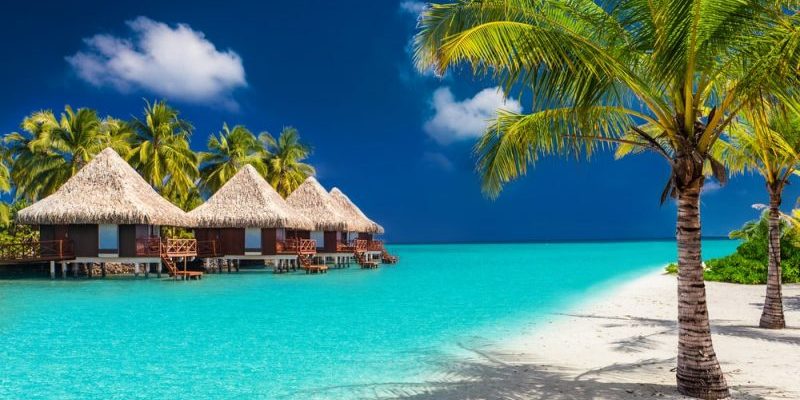
The Indian Ocean is home to a large number of islands that are popular tourist destinations thanks to their pristine sand beaches and their warm, clear waters. Among the most popular are the Maldives and the Seychelles. These islands are frequent stops on the itineraries of the world's most luxurious cruises.
2004 tsunami
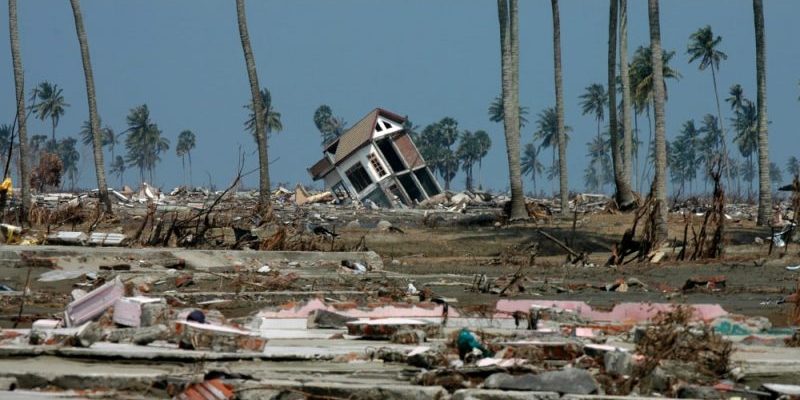
On December 26, 2004, an undersea earthquake with a magnitude of 9.1 on the Richter scale occurred in the Indian Ocean off the coast of Sumatra, Indonesia. This earthquake produced a tsunami that traveled at high speed across the Indian Ocean, striking the coasts of Indonesia, Thailand, Sri Lanka, India, and Somalia. The speed and size of the waves were such that they brought about the death of over 275,000 people, as well as massive damage to coastal infrastructure and huge property loss.
The Indian Ocean in world history
The Indian Ocean has hosted global trade routes for centuries. Some of them include:
- Spice Route. During the Middle Ages and the early modern period, the Indian Ocean maritime routes played a key role in the spice trade. Valuable goods such as pepper, cloves, and cinnamon were transported from Asia to Europe across the Indian Ocean.
- Trade in goods. Besides spices, the Indian Ocean was central to the trade of other types of goods, such as silk, porcelain, ivory, cotton, gold, and precious stones. These goods were traded along the maritime trade routes by the different cultures and civilizations bordering the Indian Ocean.
- Colonial routes. During the era of European exploration and colonization in the 15th and 16th centuries, the colonial powers established ports and colonies along the Indian Ocean coastline. The colonies served as strategic bases for the control of trade routes, and facilitated the trade of goods between Europe, Africa, and Asia.
Explore next:
References
- Acosta, M. B. (2022). Monzones: qué son, tipos y consecuencias. EcologíaVerde. https://www.ecologiaverde.com/
- Cueto, J. (2019). Tsunami del océano Índico de 2004. “La ola fue una explosión y al segundo estaba en lo profundo del mar ahogándome”. BBC News Mundo. https://www.bbc.com/
- GeoEnciclopedia. (2023). Océano Índico. https://www.geoenciclopedia.com/
- National Geographic. (2010). Océanos. https://www.nationalgeographic.es/
- Portillo, G. (2023). Qué son y cómo se forman las corrientes marinas. Meteorología en Red. https://www.meteorologiaenred.com/
Was this information useful to you?
Yes NoThank you for visiting us :)